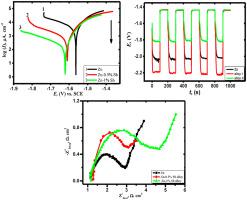International Journal of Hydrogen Energy ( IF 8.1 ) Pub Date : 2021-07-21 , DOI: 10.1016/j.ijhydene.2021.07.014 Abd El-Rahman El-Sayed 1 , Hoda A. El-Shafy Shilkamy 1 , Mahmoud Elrouby 1

|
The processes of hydrogen evolution reaction and anodic dissolution of zinc and zinc-antimony alloys with different antimony amounts (0.5 and 1%) immersed in 6 M KOH were tested via many electrochemical methods as Tafel polarization, cyclic voltammetry (CV), impedance spectroscopy (EIS), and charge-discharge. Newly formed phases, the morphology of the surface, and chemical composition for Zn and Zn–Sb alloys after and before corrosion were determined via appreciated analysis instruments as X-ray diffraction (XRD), scanning electron microscopy (SEM) provided with an energy-dispersive X-ray spectroscopy detector (EDS). The results of Tafel plots exhibited that, the protection efficiency of corrosion (η%) gets greater with the increase of both temperature and Sb content. It is impressive to note that, η% for Zn–Sb alloy (1%Sb) reaches the highest value of 98.55% at the higher studied temperature (55 °C). The potential of corrosion (Ecorr.) is shifted to a more negative position with the increase of antimony addition to zinc. This reveals that minor alloying amounts of Sb with Zn plays an important role to improve the suppression of the evolved hydrogen, charge efficiency, capacitance, and lifetime of alkaline batteries. Surface investigations revealed the presence of ZnSb and Zn4Sb3 phases on the alloy surface have an essential function in the protection of zinc anodes, and improvement of charge-discharge.
中文翻译:

追踪向锌中添加少量锑对作为碱性电池应用阳极的锌的析氢和阳极溶解过程的影响
通过塔菲尔极化、循环伏安法(CV)、阻抗谱( EIS)和充放电。Zn 和 Zn-Sb 合金在腐蚀前后的新相、表面形貌和化学成分通过 X 射线衍射 (XRD)、扫描电子显微镜 (SEM) 等分析仪器测定色散 X 射线光谱检测器 (EDS)。Tafel 图的结果表明,随着温度和 Sb 含量的增加,腐蚀保护效率 ( η % ) 变大。令人印象深刻的是,Zn-Sb 合金 (1%Sb) 的η % 在更高的研究温度 (55 °C) 下达到最高值 98.55%。随着添加到锌中的锑的增加,腐蚀电位 (E corr. ) 转移到更负的位置。这表明,少量的 Sb 与 Zn 合金化对改善碱性电池的析氢抑制、充电效率、容量和寿命起着重要作用。表面研究表明,合金表面存在 ZnSb 和 Zn 4 Sb 3相,在保护锌阳极和改善充放电方面具有重要作用。


















































 京公网安备 11010802027423号
京公网安备 11010802027423号